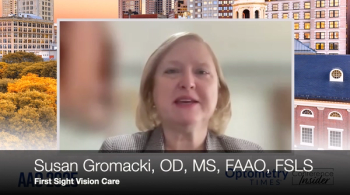
New treatment guidelines update retinal disease management
Treatment of arterial and venous occlusive diseases often involves consultations with and referrals to ophthalmologists and retina specialists.
Key Points
Tacoma, WA-Treatment of arterial and venous occlusive diseases often involves consultations with and referrals to ophthalmologists and retina specialists. However, optometrists can identify the underlying cause of these diseases in their patients, and it is often hypertension, Jay M. Haynie, OD, FAAO, said recently.
Dr. Haynie reviewed the treatment of several retinal conditions and noted that the referral guidelines he described were not necessarily the current standard of care, but rather, what he would recommend to optometrists.
He began by discussing treatment and referral of branch retinal artery occlusion (BRAO). "With any arterial occlusion, it's important that we try to lower the IOP. This creates vasodilation, and potentially, the goal is to dislodge the plaque and have it move downstream. You must then reperfuse the area in hopes of sparing the photoreceptors and limiting the scotoma the patient will ultimately have," Dr. Haynie said.
He also recommends aspirin for patients with arterial occlusive disease, if they have no contraindications. Brimonidine (Alphagan, Allergan) is another drug that may be beneficial for the treatment of arterial and venous occlusions, Dr. Haynie noted.
"It is becoming evident in the glaucoma literature that brimonidine applied topically to the eye reaches the vitreous in enough concentration to activate the alpha-2 receptors that are responsible for the initiation of neuroprotection," Dr. Haynie explained.
The standard management of BRAO is to lower IOP, prescribe brimonidine for about 6 weeks or until vision improvement has reached a plateau, and use optical coherence tomography to monitor edema. The clinician should also try to find the origin of the plaque embolus by performing carotid auscultation, then refer the patient to a primary care provider for vascular studies.
When examining a patient with reduced visual acuity from central retinal artery occlusion (CRAO), look at vasculature in the retina for clues to what is going on or may have happened in the past, he said. With CRAO, erythrocyte sedimentation rate and C-reactive protein testing must be performed immediately to evaluate the risk of giant-cell arteritis.
Ocular findings should be treated to the extent possible in the optometric practice, and the patient should be referred for paracentesis and appropriate vascular services. The worst thing that could happen is to make the patient wait, Dr. Haynie emphasized. The receptionist should be trained to recognize CRAO as a sight-threatening emergency and defer questions about paperwork and billing until later.
He also urged doctors not to give up on patients too soon by assuming that sudden, severe vision loss cannot be reversed if more than 90 to 100 minutes have passed since the onset of symptoms. Aggressive measures may restore vision to the counting fingers and hand motion level, even if the attack occurred several days earlier.
Do not delay BRVO referral
Discussing the management of venous occlusive diseases, he said that his practice is moving away from the standard of care for branch retinal vein occlusion (BRVO), which is to wait 3 months before determining if a referral is necessary. According to Dr. Haynie, it makes no sense to delay care, since vision loss starts with chronic BRVO and there are effective treatments for macular edema, including grid laser photocoagulation, topical medications, and sub-Tenon's or intravitreal injection.
The clinician also needs to address the ischemia by following patients with BRVO regularly, watching for neovascularization elsewhere, and investigating the underlying cause of the occlusion, which is usually hypertension. Dr. Haynie also urged clinicians not to "create a problem" by insisting on treatment if a patient has vision better than 20/40 and is satisfied with that.
CRVO and CSME
When treating patients with central retinal vein occlusion (CRVO), the clinician must differentiate between ischemic and nonischemic causes because the prognosis is so different. In addition, if a patient has bilateral vein occlusions of any kind, a hypercoagulable workup should be ordered since it is not uncommon for these patients to have an underlying disease different from hypertension or diabetes, such as a hyperviscosity condition.
To treat nonischemic CRVO, give brimonidine for 6 to 12 weeks, refer the patient to an internal medicine specialist, and make a referral to a retina specialist in the first month. For ischemic CRVO, flip the order of referrals, Dr. Haynie said, because it is more important for a retina specialist to stabilize the eye than for the patient to be seen by an internist.
Discussing treatment for clinically significant macular edema (CSME) in patients with refractive or recurrent diabetic retinopathy, Dr. Haynie suggested that clinicians should begin to think about other possibilities. Sleep apnea, for instance, is a significant risk factor for recurrent macular edema, and a review of the patient's medical profile could reveal other clues.
FYI
Jay M. Haynie, OD, FAAO
Phone: 253/272-9245
E-mail:
Dr. Haynie has received honoraria from Carl Zeiss Meditec and Reichert Technologies; however, he has no financial interests in the subject of this presentation.
Newsletter
Want more insights like this? Subscribe to Optometry Times and get clinical pearls and practice tips delivered straight to your inbox.


















































.png)


